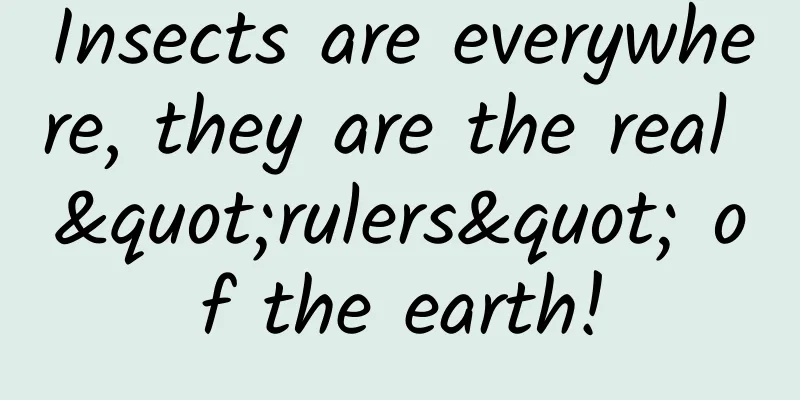Insects are everywhere, they are the real "rulers" of the earth!

|
The winning works of the 2023 "China Science Popularization Star Creation Competition" Author: kyo In the long history of the earth, which species have flourished and been unrivaled? Dinosaurs? They did stand at the top of the food chain of the entire Mesozoic era, but with the advent of the mass extinction event, they have long disappeared. We can only imagine their former majestic appearance through the remaining bones and fossils; humans? We have indeed become the masters of the earth in just a few thousand years, but compared with the 6.5 billion years of the earth, thousands of years are just a drop in the ocean. We can only be regarded as a fleeting visitor to the development of the earth. So, is there a creature that has ruled the earth and spread all over the world, and has continued to this day? There really is, that is insects-before the appearance of dinosaurs, they once dominated the entire Carboniferous period and were the undisputed overlords of the Paleozoic era; after falling from the top of the food chain, insects have become an indispensable member of this planet, not only occupying half of the species on the earth, but also multiplying and spreading to every corner of this continent. But for a long time, we didn't know much about insects-what did they look like hundreds of millions of years ago? How did they evolve? What impact did they have on our lives? If you want to find out, why not take the time train and start looking for the answer from the Carboniferous period. This is the Carboniferous period 300 million years ago, which was an active period of crustal movement. Along with the changes in landforms, the land area continued to increase. Coupled with the warm and humid climate at that time, forests and swamps spread all over the land, providing insects with a wide range of activities and abundant food sources. With the help of the right time and place, insects embarked on the road to conquer the earth. The feathery gills of aquatic insects gradually evolved into wings, making insects the first creatures to evolve the ability to fly... Look, it is flying towards us, be careful not to be discovered by it. Don't you think it looks familiar? Yes, it is the ancestor of the dragonflies we are familiar with - Meganeura. It is no different from the dragonflies today, with a slender body, huge compound eyes and two pairs of transparent wings. The only difference is the difference in size - the wingspan of Meganeura reaches 0.75-1 meter, which is 6-9 times that of modern dragonflies, and the body length is 10 times that of modern dragonflies! In the Carboniferous period when other creatures were still clumsily crawling on the ground, the flying Meganeura could be called a "dimensionality reduction strike". They used their visual advantage to lock onto their prey, then flew at low altitude, captured it with the hooks on their legs, and then tore the prey into pieces with their powerful jaws for a full meal. You may be curious about why the giant dragonfly is so huge? In fact, it is not just the giant dragonfly. There are also 2.6-meter-long giant millipedes, 0.6-meter-long horseshoe crabs and mouse-sized cockroaches on the land in the Carboniferous period. No wonder the Carboniferous period is called the "Giant Insect Age" by later generations. The reason for the giantization of insects is closely related to their living environment-forests and swamps. The Carboniferous continent was covered with plants, which emitted excessive oxygen into the sky, causing the oxygen content in the atmosphere to reach 30%, almost twice the oxygen content in the atmosphere today. Biologists believe that such an oxygen-rich environment is enough to meet the metabolic needs of insects, causing insects that lack natural enemies to grow huge; but some biologists believe that the oxygen-rich environment is harmful to insects, and they have to grow huge to reduce the damage of oxygen to the body. Although there is still no conclusion, the only thing that can be confirmed is that the giant insects of the Carboniferous period occupied the top of the food chain, and they were the masters of the planet at that time. At the same time, small insects represented by the ancestors of beetles and bees also sought living space under the shadow of giant insects, forming a Carboniferous food chain dominated by insects. Why did the giant insects disappear without a trace, leaving only their smaller counterparts to survive to this day? We can find the answer by looking at the thick dead branches and leaves under our feet - throughout the Carboniferous period, the continents were covered with layers of plants, which sank into the soil after death and turned into coal. After 100 million years, these coals accumulated into a 30-meter-thick coal layer that spread all over the world, like an unstable gunpowder barrel. With just a fuse and a match, it can burn all over the world. Finally, a certain crustal movement caused magma to erupt, and the coal layer began to burn under the action of high temperature. Eventually, the fire spread from underground to the ground. Under the action of the oxygen-rich environment, it burned violently, igniting one tree, two trees, and igniting large tracts of forests, and finally spreading into an endless sea of fire. This is the mass extinction of species in the Carboniferous period - the Carboniferous coal burning event. The giant insects not only lost the humid environment they depended on for survival, but also could not find any corners to hide in as the fire spread. Even the giant dragonflies could not find a branch to rest. After being exhausted, they fell into the sea of fire and were swallowed by the flames. The fire burned for ten years, burning most of the surface of the continent. Only the areas separated by mountains and rivers survived. The toxic gases produced by coal combustion had a great impact on species with a high demand for oxygen, and the remaining giant insects also died in large numbers due to respiratory problems. Coupled with factors such as food shortages after the disaster, the giant insects died out. Only smaller insects that were more adaptable to extreme environments survived. How could they find their own way out in the new environment after losing their dominant position? This is the Permian period, millions of years after the coal burning event in the Carboniferous period. After a long period of recuperation, the earth has resumed its thriving appearance, reptiles have become the new overlords, and insects have become the objects of prey. In order to survive, insects have to evolve in a new direction in order to find their place in the new food chain. What is crawling towards us is the representative of insect evolution in this period - cockroaches. Of course, this cockroach is not the same cockroach. The familiar "Xiao Qiang" and the Blattodea to which it belongs did not appear until the Jurassic period 100 million years later. The cockroaches here are actually the ancestors of "Xiao Qiang" - cockroach-like insects under the order Polyneoptera. As a survivor of the coal burning event in the Carboniferous period, the order Polyneoptera is not only the continuation of insect species, but also a representative of the insect's tenacious vitality and super evolutionary ability. In the species extinction event at the end of the Permian period, the small insects under the order Polyneoptera not only survived with their super adaptability, but also gradually differentiated and took different evolutionary paths to form the modern categories we are familiar with: one branch climbed up the food chain, they became carnivorous insects, lived by catching other insects, and evolved catching feet, which is the mantis under the order Mantis; the other branch was content with the status quo, lived on the corruption and excrement of other organisms, and continued to play the role of decomposer at the bottom of the food chain, which is the cockroach under the order Blattodea. Later, some cockroaches changed their eating preferences and living habits during the evolution process. They began to feed on trees and showed obvious group organization and class division of labor. This is the termite under the order Isoptera. With the deepening of insect research, termites have now "recognized their ancestors" with the help of scientists, incorporated into the order Blattodea, and become relatives of cockroaches. Let's go back a few million years to the Mesozoic Era after the Permian Period. In addition to the small insects under the order Polyneoptera, other insects also began to emerge. They and the emerging organisms, especially angiosperms, jointly built a diverse and complex co-evolution mechanism. What is the relationship between insects and plants? We often oppose the relationship between herbivorous insects and plants, as if there is only a "eater" and "being eaten" relationship between the two. This concept is wrong. In fact, insects and plants are interdependent and cannot do without each other: the feeding behavior of insects is not only an important channel for pollination between plants, which enables plants to form rich and diverse flower forms and flower structures, but also enables plants to evolve different defense mechanisms for self-defense, which accelerates the evolution of insects. In the game process of "you have a plan, I have a ladder", plants and insects continue to evolve towards unknown areas, creating today's astonishing diversity of insects and angiosperms. In the Cretaceous period of the late Mesozoic Era, with the emergence of angiosperms on the historical stage, insects also underwent tremendous changes. Complete metamorphosis insects were a new force that rose rapidly during this period. What are complete metamorphosis insects? The so-called complete metamorphosis insects refer to insects whose development process includes four stages: "egg", "larva", "pupa" and "adult". The morphology and habits of each stage are different: for example, the larval stage is only responsible for accumulating nutrients, the pupal stage is only responsible for rapid growth, and the adult stage is responsible for feeding and reproduction. Due to the huge differences in different stages, complete metamorphosis insects can not only occupy different ecological niches at different stages, avoid direct competition between larvae and adults, and reduce internal consumption, but also reasonably allocate energy to complete different tasks at different stages, greatly increasing the survival and reproduction rate. In addition, since there is a possibility of variation in each stage, the diversity of complete metamorphosis insects has also greatly increased, making it easier to retain the fire of species survival in harsh natural environments. These characteristics have made complete metamorphosis insects eventually become one of the most successful creatures on Earth. After hundreds of millions of years, we can still find these insects around us. The reason why holometabolous insects are closely related to the emergence of angiosperms is that they play an important role in pollination and pollination, such as bees and ants under the order Hymenoptera, beetles under the order Coleoptera, and butterflies and moths under the order Lepidoptera, which are still important media for plant reproduction today. In the long process of evolution, some holometabolous insects took a different approach and began to play other roles in the ecosystem: for example, flies and mosquitoes under the order Diptera, which took on the work of decomposers at this time, allowing the corpses and excrement of dinosaurs and other creatures to return to nature. Although we avoid them, the value and role of mosquitoes and flies in nature are much greater than those of us humans. Insects continued to multiply and evolve on Earth until the late Cretaceous period, when an asteroid hit the Earth and the mass extinction event reappeared. With the disappearance of the dinosaurs, the Earth entered the Cenozoic Era, and the insect world we are familiar with was formed until today. From the giants of the Carboniferous period to the small insects of today, in addition to self-evolution in accordance with the environment, how do weak insects avoid external threats, survive and reproduce to this day? This is closely related to their survival strategies. If the insect world is compared to the rivers and lakes, then in order to survive, some insects also have their own unique martial arts, which can ensure their safety and escape when they encounter danger. What are their schools? They can be roughly divided into three categories: intimidation school, camouflage school and disguise school. In academia, these three schools have another name: "Batesian mimicry", "Mu's mimicry" and "hidden mimicry". What is mimicry? Mimicry refers to the phenomenon that one organism imitates another organism or other objects in the environment to gain benefits. Insect mimicry has a long history. As early as the Jurassic period, the wings of lacewings had developed stripes like gymnosperm leaves, and the veins of their wings also became leaf-like. These are all examples of early insects using mimicry to avoid natural enemies. After entering the Cenozoic Era, with the continuous evolution of insects and the increase of external threats, the mimicry strategies of insects have become more complex and diverse, and eventually formed a way of survival represented by the above three mimicry. Batesian mimicry, also known as intimidation, refers to a survival strategy in which non-toxic, edible insects imitate the appearance of other poisonous, inedible insects to deceive predators. The black-striped dwarf butterfly living in North America is a loyal supporter of this strategy. The non-toxic butterfly deceives its natural enemies by imitating the poisonous monarch butterfly since childhood, thus avoiding the fate of being preyed upon. If you compare the two butterflies together, you will be shocked by the black-striped dwarf butterfly's super "copycat ability": not only are their body shapes similar, but even the color distribution of their wings and the direction of their wing veins are surprisingly consistent. If you are not a professional, it is difficult to distinguish the subtle differences between the two. In addition, syrphid flies, tube syrphid flies, deer moths and clearwing moths also retain the black and yellow appearance characteristics, which look no different from bees from a distance, which is enough to dispel the desire of most predators to attack. Compared with Bayesian mimicry, Mussoni mimicry is a camouflage school that goes a step further. It specifically refers to the survival strategy of two poisonous and inedible insects that imitate each other in appearance. It sounds a bit redundant to imitate other species when you already have defensive measures? But in fact, this is precisely the wonderful survival philosophy of insects: the lessons learned from successive losses are enough to make predators stay away from all similar insects, thereby reducing the probability of predation of both insect populations and ensuring the continuation of species. Mussoni mimicry is not uncommon. The common bees, wasps and hornets have stingers, and they are all black and yellow in color, which plays a role in protecting each other; the poisonous fox-eye sleeve butterfly and apple silk butterfly are not only extremely similar in appearance, but can even correspond to each other in different wing colors and patterns, which makes people have to admire the ingenuity of nature. Batesian mimicry and Mussoni mimicry are mutual imitations between insects. The disguise school represented by cryptic mimicry takes a different approach, starting from the environment to create a living space for itself: by changing the color and shape of the body surface, it makes itself look the same as dead branches, fallen leaves, stones, etc., blending into the natural environment to avoid alerting predators. The representatives we are more familiar with are dead leaf butterflies and stick insects. Not only are they similar to dead leaves and branches in appearance, but they will also remain motionless when encountering danger, blending into the plants, thus avoiding the sight of natural enemies and preserving their lives. In addition to plant-type cryptic mimicry, there is another branch, called foreign-type cryptic mimicry: the larvae of swallowtail butterflies and some small moths are very similar in appearance to bird feces. Compared with dead leaf butterflies and stick insects, they disguised as feces can not only avoid predators, but also avoid being accidentally eaten or injured by "passers-by" who do not know why, which can be called an advanced version of cryptic mimicry. In addition to survival, many insects also have to work hard on reproduction to ensure that their offspring can be born, even at the cost of their own lives - male insects need to be killed and eaten by female insects during mating to become nutrients for the birth of new life. This phenomenon is called "cannibalism" and is more common in mantises and spiders. Why do female insects eat male insects? First of all, females of this type of insect are often larger and stronger than males, and have absolute initiative in the mating process. In the eyes of females, males who come to seek love are not only lovers, but also food for them to slaughter. If they are hungry, they are a good choice to fill their stomachs; and for males, they are also willing to be eaten by females in exchange for the opportunity to mate. For example, most male red-back spiders will actively twist their bodies during mating and move themselves to the mouth of the female spider, hoping to be eaten by the female. Of course, there are some tricks here: while being eaten by the female spider, the male spider can still mate and make more eggs become its children. Compared with the great love stories, the confrontation and conquest between different sexes is the eternal theme of the tribe. "Cannibalism" is the conquest of males by females who have the initiative in reproduction, while males are looking for ways to compete with them. The entire tribe is also constantly evolving in the long process of the game between the sexes, looking for the best strategy for reproduction and survival. Due to premature differentiation in the evolutionary process, our impression of insects is not as friendly as that of other mammals. Their limbs, mouthparts and wings often make us afraid and stay away from them. But in the eyes of scientists, this is the cohesion of insect evolutionary philosophy and the crystallization of wisdom, and it is an important reference for scientific innovation, such as butterflies and satellites. In the process of satellite development, there is a problem that makes scientists puzzled: when the rotating satellite in space is directly exposed to the sun, the surface temperature will reach 2000℃, and when it rotates to the shadow area, the temperature will drop sharply to about minus 200℃. Extreme temperature changes in a short period of time can easily cause damage to the machines in the satellite. Is there any way to avoid this situation? Scientists set their sights on butterflies. The tiny scales on the surface of butterflies can control the surface temperature by closing. When the surrounding temperature is too high, the scales automatically open to refract sunlight and reduce the absorption of heat energy; when the surrounding temperature is too low, the scales automatically close to allow direct sunlight and absorb heat. Inspired by this, scientists installed movable heat sinks on satellites that can open and close like a butterfly to prevent large fluctuations in the internal and external temperatures of the satellite. In addition to science and engineering, the living habits of insects have also inspired the development of sociology. Edward Wilson, an American naturalist, explained the origin of collective consciousness and dedication by studying the group life and organizational structure of ants, and founded a new discipline based on this - sociobiology. You may not have heard of this discipline, but it provides a new answer to a difficult problem in the biological community, that is, the reason for the emergence of altruism, that is, "Why do people sometimes risk their lives to save others?" According to Darwin's theory of evolution, such behavior that goes against the continuation of one's own genes is unreasonable, and it should be eliminated in the long evolutionary competition. But obviously, this statement is contrary to reality. The biological world is full of love and even self-sacrifice, and evolution cannot explain this phenomenon. Later, William Hamilton proposed the "kin selection" theory, arguing that the basis of altruism is the blood relationship between the two, and altruistic behavior will only appear in the same species to ensure the continuation of the group. However, Wilson's experiment confirmed that even if ants of different species live and grow up together, they will exhibit altruistic behavior. In addition, there are also cases in human society where people sacrifice their lives to save strangers. "Kin selection" cannot fully explain this phenomenon. Wilson's "group selection" theory based on ant research provides a new perspective to explain altruism: the origin of altruism is not kinship, but the common growth of the group. In the process of getting along day and night, individuals have learned to divide labor and cooperate. They are not only willing to give everything for the group they are in, but also willing to sacrifice themselves to protect other compatriots and ensure the continuation of the group. The behavior represented by altruism, which creates connections, cooperation and competition with others, deepens the deep interaction between individuals and groups and even society, and becomes an important driving force for social evolution. Insects, the dominant species in the Carboniferous period, gradually differentiated and evolved in the Permian period, and rose together with angiosperms in the Cretaceous period, becoming an inseparable part of the Earth. Over hundreds of millions of years, they have experienced four mass extinction events, each of which almost ended all life. Only insects have witnessed the rise and fall of countless species and the changing climate. They still survive tenaciously on Earth and have become the most diverse and largest biological group on Earth. We have reason to believe that if one day the surface of the Earth suffers another devastating blow, it may not be humans who rise again from the ruins, but more likely ants, cockroaches and mosquitoes; and they will continue to evolve in the new environment and become an indispensable part of the new ecology. Their battle with nature will continue forever, endlessly. |
<<: Will using a humidifier cause "humidifier pneumonia"? Remember these 5 points for correct use
>>: Are people around you having fever and coughing? Common respiratory infections include these →
Recommend
How does Tmall create anthropomorphic IP?
People say that the "New Year atmosphere&quo...
After the age of 50, the incidence of osteoporosis in women is more than 5 times that in men! One minute to check if you are a "high-risk group"
Today (October 20) is the 27th World Osteoporosis...
3 steps to analyze user churn
What is user churn ? This can be judged by the TA...
Discover the value of ACG creation. Who will be the ACG IP incubator?
The copyright dispute of "Legend of Miyue&qu...
What! Tangshan, a city that mines coal and makes steel, is actually the best in the country in terms of pufferfish farming?!
Pufferfish is a fantastic ingredient that has a p...
Watching videos on your phone, getting more and more addicted - is being addicted to social media a disease?
In addition to meeting strict disease diagnostic ...
International Day of Forests丨What can we do to protect the “lungs of the earth”?
Hundreds of millions of years ago A group of alga...
Does eating sweet potatoes make you fat or lose weight? What is the difference between sweet potatoes and purple potatoes? Finally it's clear
How many people can resist the fragrant sweet pot...
6 steps to teach you how to write a perfect product promotion plan
I have no idea how to promote a new product every...
2021 Massive Engine Performance Advertising Marketing Plan
After a brand has been exposed to a large number ...
QQ Members’ 20th Anniversary New Feature “Energy Value” Launched: See How Much Your QQ Is Worth
QQ Member was born in 2000. On its 20th anniversa...
Shanghai official reminder! Doing this is very dangerous!
Recently, Shanghai's rumor-busting platform c...
Ninebot E-Series Test Drive Experience: This is what a motorcycle should look like in the Internet era
In recent years, with the deteriorating environme...
Cold rice has no calories? Is there heavy metal residue in rice? You may have a misunderstanding about rice
Rumors 1. White rice has no nutritional value 2. ...
"If you don't dry your quilt in the sun for years, you will have millions of mites sleeping with you." This is not a joke
"If you don't dry your quilt in the sun ...









